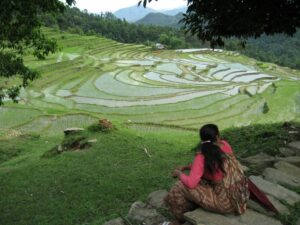In the Philippines, a country with 1,001 fiestas, town celebrations tend to become indistinguishable from one another. Brass marching bands, multicolored buntings, and dining tables on the verge of collapsing under the sheer weight of food are common denominators of town fiestas. But Lucban, a bustling yet quaint town in the province of Quezon, Philippines, has managed to elevate its fiesta into a cultural icon.
Every 15th of May, Lucban undergoes a fantastic transformation as its people celebrate the famous Pahiyas festival. It is an annual celebration, during which the townsfolk offer their heartfelt gratitude for the year’s harvest to Saint Isidore (San Isidro Labrador), the patron saint of farmers.
The sowing and harvesting of rice, as well as other agricultural crops, have been the basic themes in Philippine folk rituals and artistic expressions since time immemorial. Pahiyas is a Filipino term that means precious offering and predates the Spanish colonial period of the country by several centuries. This celebration was originally an animistic ritual practiced by the pre-Christian Filipinos to honor their rice god, Ampo’t Paray, and to ask for bountiful harvests in the coming year. Saint Isidore did not come into the picture until the 16th century through Spanish friars and missionaries who introduced Western and, in particular, Roman Catholic Christian values into the country’s cultural and religious practices. The festival itself, however, retained its original core of thanksgiving and prayers for more abundant harvests to come.
Coincidentally, when St. Isidore was introduced to the local people, bigger harvests overwhelmed the town, which then boosted the saint’s popularity—not to mention convincing more people to convert to the Roman Catholic religion.
In fact, the bumper crop grew with time until the church of Lucban, where the harvests were stored as offerings to the saint, could no longer accommodate them. As an alternative, farmers displayed their harvests in front of their houses so that the priest could bless them as he made his way around town during the annual procession. Through the years, this practice turned into a contest of creativity as households tried to outdo each other and the offerings evolved into eye-catching decorations.
Hence, homes—from the most humble to the more affluent—that would otherwise be nondescript on ordinary days are dressed up in full fiesta using fruits, vegetables, rice panicles and straws, flowers, pandan leaves, and ferns, but mostly kiping.
Kiping (“keeping”) is a leaf-shaped wafer made of rice dough and vividly dyed with food coloring. Kiping wafers are entirely edible and are usually deep-fried in small pieces or cooked whole over charcoal.
Kiping is best eaten with some sugar because it is not the most flavorful food in the world. However, what kiping wafers lack in palatability, they more than make up for in visual creativity. They are strung together to form lanterns, multitiered chandeliers, and gigantic butterflies and flowers. The visual effect is truly astounding, and, during the three-day celebration, Lucban is awash in colors that match the intensity of the people’s devotion to their patron saint and their passion for their centuries-old tradition.
Notably, although Pahiyas is largely a religious occasion, it inspired the Philippine government, under President Gloria Macapagal-Arroyo, to launch in 2004 the Panagyaman (Thanksgiving) Rice Festival to pay tribute to the farmers and to highlight the significance of rice to every Filipino household. Rice farmers play the most important role in national food security as they serve as the country’s backbone in the national campaign for a hunger-free Philippines. April now marks the rice festival month as it ushers in the harvest season for rice.









